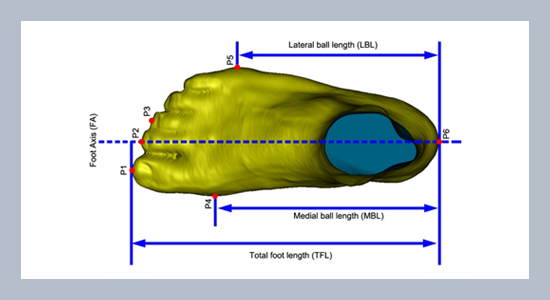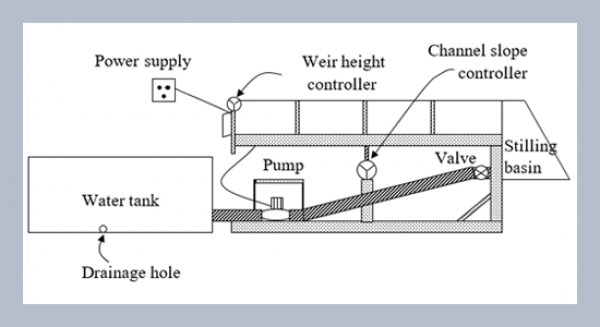REFERENCES
- Arnold, J.B., Bishop, C. 2013. Quantifying foot kinematics inside athletic footwear: A review. Footwear Science, 5, 55–62.
- Butler, R.J., Hillstrom, H., Song, J., Richards, C.J., Davis, I.S. 2008. Arch height index measurement system: Establishment of reliability and normative values. Journal of the American Podiatric Medical Association, 98, 102–106.
- Cobb, S.C., James, C.R., Hjertstedt, M., Kruk, J. 2011. A digital photographic measurement method for quantifying foot posture: Validity, reliability, and descriptive data. Journal of Athletic Training, 46, 20–30.
- Cowan, D.N., Jones, B.H., Robinson, J.R. 1993. Foot morphologic characteristics and risk of exercise-related injury. Archives of Family Medicine, 2, 773–777.
- Cornwall, M.W., McPoil, T.G. 2011. Relationship between static foot posture and foot mobility. Journal of Foot and Ankle Research, 4, 1–9.
- Dempster, W.T., Gaughran, G.R.L. 1967. Properties of body segments based on size and weight. American journal of anatomy, 120, 33–54.
- Franettovich, M.M., McPoil, T.G., Russell, T., Skardoon, G., Vicenzino, B. 2007. The ability to predict dynamic foot posture from static measurements. Journal of the American Podiatric Medical Association, 97, 115–120.
- Houston, V.L., Luo, G., Mason, C.P., Mussman, M., Garbarini, M., Beattie, A.C. 2006. Changes in male foot shape and size with weightbearing. Journal of the American Podiatric Medical Association, 96, 330–343.
- Kaufman, K.R., Brodine, S.K., Shaffer, R.A., Johnson, C. W., Cullison, T.R. 1999. The effect of foot structure and range of motion on musculoskeletal overuse injuries. The American Journal of Sports Medicine, 27, 585–593.
- Kimura, M., Mochimaru, M., Kanade, T. 2011. 3D measurement of feature crosssections of foot while walking. Machine Vision and Applications, 23, 377–388.
- Kramer, P.A., Lautzenheiser, S.G. 2022. Foot morphology influences the change in arch index between standing and walking conditions. The Anatomical Record, 305, 3254–3262.
- Krauss, I., Valiant, G., Horstmann, T., Grau, S. 2010. Comparison of female foot morphology and last design in athletic footwear—are men's lasts appropriate for women?. Research in Sports Medicine, 18, 140–156.
- Lees, A., Lake, M., Klenerman, L. 2005. Shock absorption during forefoot running and its relationship to medial longitudinal arch height. Foot & Ankle International, 26, 1081–1088.
- Luo, G., Houston, V.L., Mussman, M., Garbarini, M., Beattie, A.C., Thongpop, C. 2009. Comparison of male and female foot shape. Journal of the American Podiatric Medical Association, 99, 383–390.
- Mall, N.A., Hardaker, W.M., Nunley, J.A., Queen, R.M. 2007. The reliability and reproducibility of foot type measurements using a mirrored foot photo box and digital photography compared to caliper measurements. Journal of Biomechanics, 40, 1171–1176.
- McPoil, T.G., Cornwall, M.W., Medoff, L., Vicenzino, B., Forsberg, K., Hilz, D. 2008a. Arch height change during sit-to-stand: An alternative for the navicular drop test. Journal of Foot and Ankle Research, 1, 1–11.
- McPoil, T.G., Cornwall, M.W., Vicenzino, B., Teyhen, D.S., Molloy, J.M., Christie, D.S., Collins, N. 2008b. Effect of using truncated versus total foot length to calculate the arch height ratio. The Foot, 18, 220–227.
- McPoil, T.G., Vicenzino, B., Cornwall, M.W., Collins, N., Warren, M. 2009. Reliability and normative values for the foot mobility magnitude: A composite measure of vertical and medial-lateral mobility of the midfoot. Journal of Foot and Ankle Research, 2, 1–12.
- McPoil, T.G., Cornwall, M.W., Abeler, M.G., Devereaux, K.J., Flood, L.J., Merriman, S.E., Sullivan, S., van Der Laan, M.J., Villadiego, T.A., Wilson, K. 2013. The optimal method to assess the vertical mobility of the midfoot: Navicular drop versus dorsal arch height difference. Clin Res Foot Ankle, 1, 1–7.
- Robinette, K.M., Daanen, H., Paquet, E. 1999. The CAESAR project: A 3-D surface anthropometry survey. 3DIM’99: Proceedings of Second International Conference on 3-D Digital Imaging and Modeling Conference, 380–386.
- Telfer, S., Woodburn, J. 2010. The use of 3D surface scanning for the measurement and assessment of the human foot. Journal of Foot and Ankle Research, 3, 1–9.
- Tu, H.H. 2014. Foot volume estimation formula in healthy adults. International Journal of Industrial Ergonomics, 44, 92–98.
- Tu, H.H., Lo, V.E.W., Liu, C.W., Liu, Y.P., Yu, C.Y., Chen, C.Y., Liu, L.W. 2021. Body volume estimation equation for male laborers in Taiwan. International Journal of Occupational Safety and Ergonomics, 27, 1207–1214.
- Pohl, MB., Farr, L. 2010. A comparison of foot arch measurement reliability using both digital photography and calliper methods. Journal of Foot and Ankle Research, 3, 1–6.
- Williams, D.S., McClay, I.S., 2000. Measurements used to characterize the foot and the medial longitudinal arch: Reliability and validity. Physical Therapy, 80, 864–871.
- Williams, D.S., McClay, I.S., Hamill, J. 2001. Arch structure and injury patterns in runners. Clinical Biomechanics, 16, 341–347.
- Xiong, S., Goonetilleke, R.S., Witana, C.P., Weerasinghe, T.W., Au, E.Y.L. 2010. Foot arch characterization a review, a new metric, and a comparison. Journal of the American Podiatric Medical Association, 100, 14–24.
- Yen, D.Y., Puffer, J.C., Schmalzried, T.P. 1998. Injuries in runners: A prospective study of alignment. Clinical Journal of Sport Medicine, 8, 187–194.
- Yu, C.Y., Lin, C.H., Yang, Y.H. 2010. Human body surface area database and estimation formula. Burns, 36, 616–629.
- Yu, C.Y., Tu, H.H., 2009. Foot surface area database and estimation formula. Applied Ergonomics, 40, 767–774.
- Zifchock, R.A., Davis, I., Hillstrom, H., Song, J. 2006. The effect of gender, age, and lateral dominance on arch height and arch stiffness. Foot & Ankle International, 27, 367–372.
- Zifchock, R.A., Theriot, C., Hillstrom, H.J., Song, J., Neary, M. 2017. The relationship between arch height and arch flexibility: A proposed arch flexibility classification system for the description of multidimensional foot structure. Journal of the American Podiatric Medical Association, 107, 119–123.
- Zifchock, R., Parker, R., Wan, W., Neary, M., Song, J., Hillstrom, H. 2019. The relationship between foot arch flexibility and medial-lateral ground reaction force distribution. Gait & Posture, 69, 46–49.















